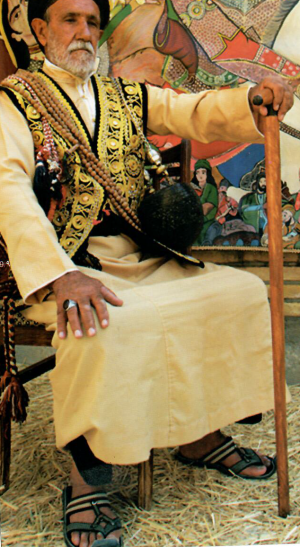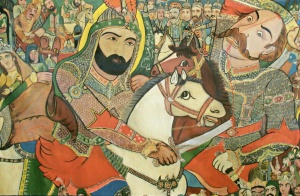Esmail nosuhi: Difference between revisions
T.ramezani (talk | contribs) m (→Narration) |
No edit summary |
||
| (3 intermediate revisions by 2 users not shown) | |||
| Line 1: | Line 1: | ||
[[fa:اسماعیل نسوحی]] | |||
{{Infobox artist | {{Infobox artist | ||
| name = Esmail nosuhi | | name = Esmail nosuhi | ||
| Line 23: | Line 24: | ||
}} | }} | ||
Esmail is skilled in performing other religious ceremonies as well as Pardekhani (curtain-storytelling). Therefore, the singing techniques of [[Rawza-Khani]] (religious recitative), [[Ta’ziya]] (sung-playing) and Chavoshi-khani (recite the songs of [http://www.iranicaonline.org/articles/aravan-pers carvans] or wars) are used in his Pardekhani performance. In Pardekhani, [https://referenceworks.brillonline.com/entries/encyclopaedia-of-islam-2/madih-madh-COM_0601 Madh] (eulogy) and [https://referenceworks.brillonline.com/entries/encyclopaedia-of-islam-2/manakib-COM_0660 Manaqib], (praise), Mosiba and [[Marthiya]] (lamentation), Sokhanvari (eloquence poetic gift) and other melodies make his Pardekhani a ceremonial vaster than just storytelling , and it can be considered as a unique method . | Esmail is skilled in performing other religious ceremonies as well as Pardekhani (curtain-storytelling). Therefore, the singing techniques of [[Rawza-Khani]] (religious recitative), [[Ta'ziya|Ta’ziya]] (sung-playing) and Chavoshi-khani (recite the songs of [http://www.iranicaonline.org/articles/aravan-pers carvans] or wars) are used in his Pardekhani performance. In Pardekhani, [https://referenceworks.brillonline.com/entries/encyclopaedia-of-islam-2/madih-madh-COM_0601 Madh] (eulogy) and [https://referenceworks.brillonline.com/entries/encyclopaedia-of-islam-2/manakib-COM_0660 Manaqib], (praise), Mosiba and [[Marthiya]] (lamentation), Sokhanvari (eloquence poetic gift) and other melodies make his Pardekhani a ceremonial vaster than just storytelling , and it can be considered as a unique method . | ||
Nosuhi, using periods made of three or sometimes four pitches in performing the rhythmic sections of Pardekhani, gradually raises his voice to the higher pitches and changes the range of pitches he uses to higher ones. In this way different atmospheres are heard which at times resemble that of Iranian musical modes (Mahur, Segah, Chahargah) or at other times not. The Pardekhan (curtain-teller) does not feel obliged to adhere to maintain the tonalities he began with, but uses a few pitches rhythmically which have a similar theme only being higher or lower in tonality. | Nosuhi, using periods made of three or sometimes four pitches in performing the rhythmic sections of Pardekhani, gradually raises his voice to the higher pitches and changes the range of pitches he uses to higher ones. In this way different atmospheres are heard which at times resemble that of Iranian musical modes (Mahur, Segah, Chahargah) or at other times not. The Pardekhan (curtain-teller) does not feel obliged to adhere to maintain the tonalities he began with, but uses a few pitches rhythmically which have a similar theme only being higher or lower in tonality. | ||
==Narration== | ==Narration== | ||
[[File:Esmail nosuhi 4.jpg|thumb|]] | [[File:Esmail nosuhi 4.jpg|thumb|]] | ||
Darvish Esmail Nosuhi narrates the battle of [[Abbas ibn Ali]] and Mared ibn Sodeif in [[Karbala]]. Mared's father is killed in the [https://referenceworks.brillonline.com/entries/encyclopaedia-of-islam-2/siffin-SIM_7018 Siffin Battle] by [[Imam Ali]] and he swears to revenge his father through Ali's son , Abbas ibn Ali. Darvish Esmail narrates the face to face of them, after describing Mared's dawning his armor and Abbas' preparation for attack. Mared is killed by Abbas in this battle. | Darvish Esmail Nosuhi narrates the battle of [[Abbas B. ʿAli B. Abu Taleb|Abbas ibn Ali]] and Mared ibn Sodeif in [[Karbala]]. Mared's father is killed in the [https://referenceworks.brillonline.com/entries/encyclopaedia-of-islam-2/siffin-SIM_7018 Siffin Battle] by [[ʿAli ibn Abi Talib|Imam Ali]] and he swears to revenge his father through Ali's son , Abbas ibn Ali. Darvish Esmail narrates the face to face of them, after describing Mared's dawning his armor and Abbas' preparation for attack. Mared is killed by Abbas in this battle. | ||
==Source== | ==Source== | ||
*Ardalan, hamidreza (2008). Picture-storyteller masters of iran, the Iranian academy of the art, 2008, volume 4. ISBN: 978-964-2986-392(vol.4). 978-964-2986-002(set). | *Ardalan, hamidreza (2008). Picture-storyteller masters of iran, the Iranian academy of the art, 2008, volume 4. ISBN: 978-964-2986-392(vol.4). 978-964-2986-002(set). | ||
[[Category: Performing Art]] | [[Category: Performing Art]] | ||
[[Category: Ritual Dramatic Art]] | [[Category: Ritual Dramatic Art]] | ||
[[Category:Artists]] | |||
[[Category:Contemporary Artists]] | |||
[[Category:Art]] | |||
Latest revision as of 14:55, 10 November 2020
Esmail Nosuhi (born in 1932) is an Iranian Pardekhan, Ta’ziyekhan, Rawzakhan, and Chavoshikhan who started his profession at the age of fifteen. He received training from several masters, such as Karbalai Nurollah Nosuhi (his father), Haj Ali Nosuhi (his uncle), and Yadollah Moqadas. His style of Pardekhani is well-known for its abstract movements.
Performance Method[edit | edit source]
Darvish Esmail fuses abstract and realistic movements in narration of the curtain, and in general the abstract movements are dominant. In his performance, abstract movements appear, with signs based on consensus or not, and the explanation of the unfamiliar abstract movements can be understood through understanding the other movements. Darvish Esmail with repeated pauses and standing in one place attempts to arrive at simplicity of expression which increases the influence of the spoken word. The changes in movements and postures in different gatherings which complement the unchanged postures and movements is the demonstration of his mastery in picture-storytelling.
Reciting Method[edit | edit source]
Esmail is skilled in performing other religious ceremonies as well as Pardekhani (curtain-storytelling). Therefore, the singing techniques of Rawza-Khani (religious recitative), Ta’ziya (sung-playing) and Chavoshi-khani (recite the songs of carvans or wars) are used in his Pardekhani performance. In Pardekhani, Madh (eulogy) and Manaqib, (praise), Mosiba and Marthiya (lamentation), Sokhanvari (eloquence poetic gift) and other melodies make his Pardekhani a ceremonial vaster than just storytelling , and it can be considered as a unique method . Nosuhi, using periods made of three or sometimes four pitches in performing the rhythmic sections of Pardekhani, gradually raises his voice to the higher pitches and changes the range of pitches he uses to higher ones. In this way different atmospheres are heard which at times resemble that of Iranian musical modes (Mahur, Segah, Chahargah) or at other times not. The Pardekhan (curtain-teller) does not feel obliged to adhere to maintain the tonalities he began with, but uses a few pitches rhythmically which have a similar theme only being higher or lower in tonality.
Narration[edit | edit source]
Darvish Esmail Nosuhi narrates the battle of Abbas ibn Ali and Mared ibn Sodeif in Karbala. Mared's father is killed in the Siffin Battle by Imam Ali and he swears to revenge his father through Ali's son , Abbas ibn Ali. Darvish Esmail narrates the face to face of them, after describing Mared's dawning his armor and Abbas' preparation for attack. Mared is killed by Abbas in this battle.
Source[edit | edit source]
- Ardalan, hamidreza (2008). Picture-storyteller masters of iran, the Iranian academy of the art, 2008, volume 4. ISBN: 978-964-2986-392(vol.4). 978-964-2986-002(set).


